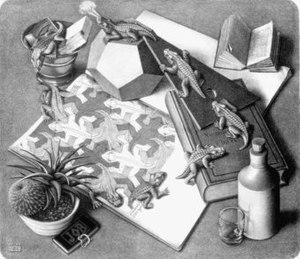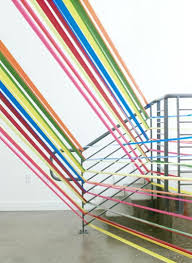
10 adjectives to describe it:
- monochrome
- surreal
- symbolic
- mysterious
- rythm
- balance
- precise
- photorealistic
- eyemovement
- repetitive
Background:
Style: creates work in a paradoxical concept with little or no meaning
he often manupulates space and perspective to create optical illusions: creating impossible images that look plausible. The use of repeating motifs can be observed from the use of cycles and continuity of his work. he was facinated with mathematics. The precision that he uses allowed him to create such believable images.
Mood of the work:
With the monochromatic colors and the lack of vibrant colors, this work looks gloomy and eerie and perhaps even give the viewer an ominous foreboding. the restless looking and seemingly slow crawling reptiles gives the work a very heavy mood with very little energy. however the bright light reflecting off the surface of the objects make it look maybe even a little hopeful. overall, the unmoving or slow moving objects makes the mood a little tense, still and silent or even serene.
Description in term of elements of art and principle of design
The reptiles ( tessellated image or the realistic image) are traveling in a circular motion. This suggests the circle of life. There's one reptile crawling "into" the page, blending/ transforming/ changing/ fitting into the tessellated image of the reptiles within the pages of the book. this created an interplay between the flat and dimensional. The two lizards entering and leaving the tessellated plane provide clue that the picture is imaginative but fundamentally about the relationship between two and three dimensional space. The image is so real yet so hard to believe that its true. Unconsciously, our mind tell us that this is possible. however consciously, our mind tells us that this is impossible! the open book with the reptiles on it looks as if this story of the cycle of reptiles is told to the viewer. and the images within the story is so realistic that it comes to life. However, the open bookis actually Escher's "visual dictionary" in which he systematically rcorded every system of interlocking figures. Every image in the work is carefully scaled and drawn to proportion and the right perspective. Escher took a great interest in geometry and what he called the "logic of space" . Tessellations, for Escher, became artistic explorations of math concepts.
what in my opinion makes this image surreal?
I feel that the fact that it cretes this illusion that makes the viewer question themselves of whether this image is real makes it surreal. Just like Renne Magritte's Personal Values, it is the notion where the viewer actually thinks for even that second that this work is real. Looking at Lucia Hartini's work, although it is surreal. With one look, the viewer can say that it is not possible that it is real. But surreal to me is the line between real and unreal. Hence with the reptiles crawling in a circle, almost like it is crawling between the three-dimensional and the two- dimensional world makes it surreal.
Artist Comparison
I am personally a fan of her's after i found out about her through the show " work of art " this show is really an inspiring show that i recommend to everyone!!!!!!!!
The first thing that caught my attention about her is this work that i found really beautiful and amazing:
Background:
Sarah Kabot is an artist who lives and works in Cleveland,
Ohio. Kabot creates installations, which are artworks created specifically for a certain space. Installation artists create an environment rather than an artwork that could be placed in any location. Sometimes an installation utilizes more than one of your five senses, like smelling and seeing. To start, Kabot does drawings and sketches of the space she will be working in. Kabot’s process for creating her installations always involves questions. She wants to understand the way everyday objects such as an exit sign or light fixture are constructed. Kabot asks us to question what we think we know about the things we see every day. According to the artist, she is “acting out her imagination of other possibilities for things...what if the ceiling was face-up on the floor?”

This is just like the staircase illusion Escher creates

i love how she plays with optical illusion with the help of shadows.

although this is a simple concept but it has a very amazing effect.

simple but complicated in a way. this is a mathematically precise installation.
the way she creates these optical illusion is , to me, very much like the illusion Escher creates. And the striking difference is of course Escher creates these three dimensional illusions on a two dimensional platform while she creates these illusions baised on a three dimensional object.
Unlike Escher, she did not create illusions that play between whats two dimensional and whats three dimensional, the precision an accuracy to create these realistic images or installations are very much like Escher's. It is just like an installation of Escher's work.
Ohio. Kabot creates installations, which are artworks created specifically for a certain space. Installation artists create an environment rather than an artwork that could be placed in any location. Sometimes an installation utilizes more than one of your five senses, like smelling and seeing. To start, Kabot does drawings and sketches of the space she will be working in. Kabot’s process for creating her installations always involves questions. She wants to understand the way everyday objects such as an exit sign or light fixture are constructed. Kabot asks us to question what we think we know about the things we see every day. According to the artist, she is “acting out her imagination of other possibilities for things...what if the ceiling was face-up on the floor?”
This is just like the staircase illusion Escher creates
i love how she plays with optical illusion with the help of shadows.
although this is a simple concept but it has a very amazing effect.
simple but complicated in a way. this is a mathematically precise installation.
the way she creates these optical illusion is , to me, very much like the illusion Escher creates. And the striking difference is of course Escher creates these three dimensional illusions on a two dimensional platform while she creates these illusions baised on a three dimensional object.
Unlike Escher, she did not create illusions that play between whats two dimensional and whats three dimensional, the precision an accuracy to create these realistic images or installations are very much like Escher's. It is just like an installation of Escher's work.
Litography:
No comments:
Post a Comment